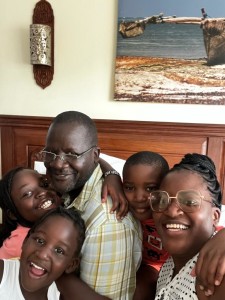Feeding Family, Feeding Community with AfriThrive
Lydiah Owiti came to the U.S. from Kenya to join her husband. They had moved several times for his job in the military, in which they served for 12 years. When his California office closed during the COVID-19 pandemic in 2020, they moved to Maryland. However, soon after arriving here with their three children — a 10-year-old son, and daughters ages 9 and 3 — the Maryland office closed as well, and Lydiah’s husband was out of work.
“Panic sets in,” Lydiah remembers. At the time, she was a full-time mom with no income of her own to fall back on. The family had just signed a lease in Maryland and, immediately, they began worrying about how they would manage.
Lydiah started exploring options, seeking connections in her new community, just as she had done with every move the family had made. Soon, she came across AfriThrive and learned that the organization provides food to African immigrant families.
Within two days of reaching out to AfriThrive, food was delivered to her doorstep. Lydiah knew they gave food out at central distribution spots, but because she was not near one of these locations, AfriThrive came to her. “That really touched me,” she says.
But food was not the only thing they offered. The people at AfriThrive wanted to learn more about their situation and find out how else they could help. “It was such an amazing thing,” Lydiah says, “to have people come out to see us and care so much.”
Thanks to the food from AfriThrive, Lydiah and her family could use their limited savings for rent. Fortunately, the military still provided for their healthcare. “Too often, families in financial straits have to choose between a place to sleep or feeding their family, but AfriThrive meant we did not have to make such a difficult choice.”
In addition, the food AfriThrive provided was not the canned food that Lydiah expected. “That’s what most food pantries provide, and while it’s very helpful, that’s not something I was used to preparing,” she remembers. “AfriThrive’s fresh vegetables, like collard greens, made me feel at home.”
Lydiah was so touched by the generosity of AfriThrive that she began volunteering herself. “People from my culture are reluctant to ask for help because they see doing so as a sign of weakness. I don’t care about that — and I knew there had to be many people who would need assistance and I wanted to volunteer my time to help.”
“I volunteered with my kids to distribute food door-to-door to our neighbors. We made so many friends along the way, and the more we distributed the more people came out who needed it.”
Lydiah’s husband landed a new job that took them to Connecticut and although she was sad to leave the AfriThrive community, she continues to stay in touch and help out with AfriThrive’s youth mentoring program. Now, she also works for Blue Star Families, a nonprofit providing suport for active duty military and veteran families.
Lydiah will always remember what AfriThrive did for her and her family at a time of great desperation. “Just seeing how someone would go out of their way for my needs and come to my doorstep was so comforting and reassuring. There’s still so much good out there, and people for whom other people’s needs are that important.”
AfriThrive pairs food with critical services that empower underserved Black immigrant and refugee families. In addition to sourcing locally grown, culturally appropriate fresh fruits and vegetables for weekly distribution to thousands of community members, they also offer a youth engagement and life skills program, as well as connects youth with employment opportunities. Learn about this work, and more, by visiting their website and subscribing to their newsletter. Support them this GivingTuesday and holiday season!

